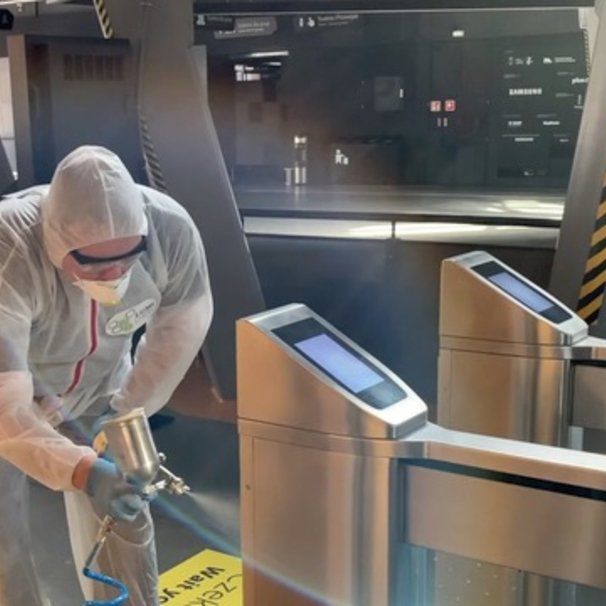Thanks to science, we managed to make the whole Centre safe, without having to constantly disinfect all exhibits and frequently touched surfaces. We covered them with a special photocatalytic coating which protects against bacteria, viruses, and fungi for 12 months!
Also, this revolutionary nanotechnological solution improves the quality of air inside our building. How is it possible? Let's get to know titanium dioxide and how unusually it behaves when met with light.
What is titanium dioxide?
Titanium dioxide (TiO2) is a white pigment called 'titanium white' which has been used in painting for a long time. Thanks to its colour enhancing and lightening properties, it has often been added to other pigments. However, as it turns out, this has led to a quicker than usual fading of colours that have contact with daylight.
Many years later, this 'defect' has inspired scientists to test TiO2 for its light sensitivity, as well as photoexcitation. And that is how titanium dioxide's career in photocatalytic industry was launched.
The next big break came with the development of nanotechnology – increased fragmentation led to a growth in TiO2 effectiveness.
Titanium dioxide is very stable, easily accessible, relatively cheap, and fully non-toxic. It is used by e.g. pharmaceutical, cosmetics, or food industries as a filler or a colouring agent.
What is photocatalysis?
It's a process in which light and photocatalysts are used to speed up chemical reactions. Photocatalytic properties of pure titanium dioxide are related to its ability to absorb radiation – mainly UV, but also, to a small extent, the radiation of the visible spectrum. To increase the effectiveness of TiO2, different substances are added, i.e. organic compounds, ions, and metal complexes. Formulas prepared this way can be used inside buildings and in poorly lit areas. The TitanSolid formula with which the surfaces of Copernicus Science Centre were coated had been additionally reinforced with LUMIbooster. This way, the coating absorbs light much more effectively; even the scattered light we find in most interiors. Thanks to a simple procedure, the TitanSolid coating works also in the visible light spectrum.
How does it work?
Titanium dioxide absorbs light when exposed to it. As soon as it absorbs a certain amount of energy, inside its micro- and nanocrystals, electrons and electron holes are created, which react with oxygen and water particles that are in the air thus creating highly reactive particles or ions, e.g. hydroxyl radical (HO•), anion radical superoxide (O2•–), hydrogen peroxide (H2O2). These compounds have very strong oxidising properties. The layer of radicals and oxidants is what effectively disintegrates all sorts of organic pollutants, like oils, fats, exhaust fumes, gases with unwanted odour, and even microorganisms, viruses, fungi, or bacteria.
A surface is covered with the formula which creates a photoactive coating. After a few ours, the coating absorbs the right amount of energy from light and reaches its full potential. Afterwards, the process goes on, even in cloudy weather or at night – using the energy accumulated in daylight. An additional effect? Clean air inside the building.
Photocatalytic coatings based on titanium dioxide are durable and keep their properties for many months. Normal usage such as cleaning, touching, or rubbing does not destroy them. And they're fully safe to use.
Thank you to Lumichem company for securing Copernicus Science Centre with photocatalytic coating.


